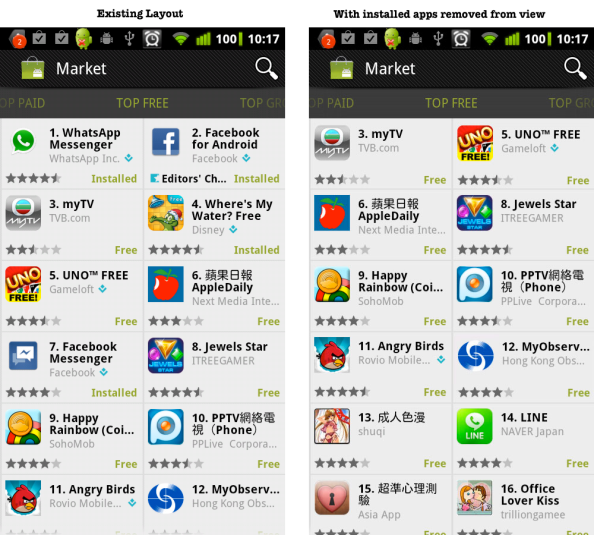Archive
Improved adblocking expected to a browser near you in Fall/Winter 2015
Web publishers primarily those with a large mobile web audience may see a big delta in pages served and ads served starting from Fall 2015 when iOS 9 and El Capitan launches. This will be coupled with improvements under the hood in Firefox 41 which should make Ad Block Plus much more efficient
Here’s a few links on the new content blocker extensions coming in iOS9 and Mac OSX El Capitan
- Introduction to WebKit content blocking
- How to write a content blocker extension in 10 minutes
- An hour with Safari Content Blocker in iOS 9
Also note that UC Browser which has a sizable userbase in fast growing smartphone markets such as India and China also comes with built in ad-blocking.
Mockup to demonstrate optimisation of Market app on Android devices
My last post described a simple personalization feature which could optimise app discovery on both the iOS and Android platforms.
Animoca has elaborated this point more lucidly and provided a mockup of how this would look on an iOS device.
I would like to share a mockup of the Android Market app which shows how apps would bubble up and become more naturally discoverable
Improving App Discovery in the iTunes Store as well as Android Market
Edit: This suggestion is expanded and elucidated more comprehensively in the official Animoca blog post
Mobile App Developers both on the Android as well as iOS ecosystem are consistently looking for more ways to have their apps discovered since they don’t buy in to “If you build it, he will come” philosophy.
Apps are discovered by users in many ways including pervasive marketing via mobile banner ads, video clips, cross promotion ads and very often discovered by users via “ranked lists” whether they be called “Top Charts” on iOS or the various Top Lists on Android Market which are quite well described via in this presentation by Eric Chu at Google I/O 2011.
Developers try very hard to get high up in the overall ranking since that improves organic discovery. This in general involves spending fair bit of money on advertising their app so that maximum users can be made aware of it or if the developer has an existing app or set of apps cross promoting amongst them.
However, lets take the viewpoint of a user who wants to discover more apps. Wouldn’t the user find the Top Lists more useful if they eliminated apps which were already installed on the users account or a device combination. This would allow apps which were ranked lower in the charts to bubble upward and thus users who had already consumed apps in the Top 10 or Top 25 content (the specific list within Android Market doesn’t really) would see other content which may have been below the fold for them and if the voracious consumers found that content to be useful, maybe that would be a signal for the app to bubble faster up the list.
Both Google and Apple have the ability to know what apps have been downloaded by a user specific to a device and/or an account and thus personalise the Top lists by eliminating apps which have already been installed by the user from the Top various lists. They would in effect become “Top lists of apps which have not been installed by the user”
This relatively simple change in my opinion would improve discovery and make the ecosystem more useful to both mobile users and app developers.
